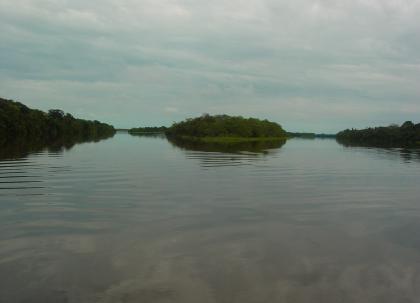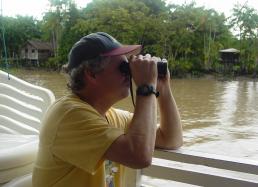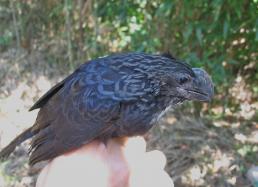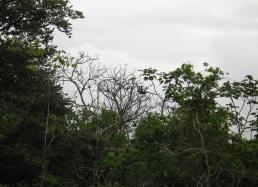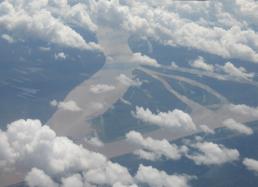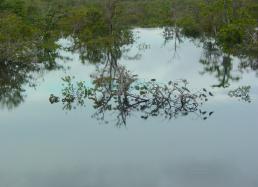Blog #3: River Journey
I love sleeping in a hammock. For me there’s nothing like rocking to sleep and listening to the sounds of the rainforest. Unfortunately, our first night was spent traveling across the Amazon River (Rio Solimões), so the only sound to be heard was the boat’s loud diesel engine, but I still got a good night’s sleep.
Shortly after dawn, the light woke all of us, and we pulled out our binoculars to start watching for birds along the riverbank (see Photo #1 below.) It quickly became apparent that we’d completed our journey across the Amazon and were already heading up the Rio Japurá. In this region of the Amazon, the Rio Solimões is anywhere from 2-4 miles across, whereas the Rio Japurá ranges from 0.8 to 4 miles in a few stretches and has many river islands. (However, the individual channels in the Japurá are usually no more than a mile across.) Even this “small” Amazonian River is quite a bit larger than our largest U.S. River, the mighty Mississippi, which is only just over one half of a mile across in Baton Rouge, Louisiana.
Our goal was to travel up the Japurá to our furthest collecting site on the south bank, then work our way downstream back towards Tefé, stopping at two other collecting sites (one on the south bank and one on the north bank) along the way.
During our trip upstream, we passed countless villages and river islands (see my "Video Journal #2: A River Village"), and throughout the day we saw a decent diversity of river-edge birds (81 species), including the Chestnut-eared Araçari (a small toucan species), Bat Falcon, Greater Ani (see Photo #2 below), and four species of macaw!
We also managed to see more Brown-throated Three-toed Sloths (Bradypus variegatus) than I’d ever seen in my entire life (see Photo #3 below.) By late morning, we’d counted around 30 sloths hanging in trees along the riverbank, as well as Tucuxi (Gray River Dolphin) and three species of monkey. To see some of the sloths, dolphins, and other critters we spied during the journey, check out my “Video Journal #3: Sights along the River.”
We also used some of the afternoon to organize our gear and equipment so that when we arrived at our first field site, we’d be ready to start studying the birds and their parasites. But mostly we sat on chairs watching the shoreline go by, occasionally spotting interesting birds.
We continued on through the night to the town of Japurá, where we planned to turn up the Rio Mapari, a tributary of the Japurá, to look for Terra Firme (unflooded) forest. (Much of the river-edge forest in Amazonia is seasonally inundated with water.) For our work, we were interested in studying birds from a variety of habitats, including not only Terra Firme forest but also Igapo (seasonally flooded blackwater-swamp forests) as these major habitats are home to completely different sets of bird species.
The next day when we awoke, we began birding from the boat immediately. During the early morning, one of the craziest things that we saw was an Undulated Tinamou (Crypturellus undulatus) floating in the river like a duck. Tinamous are flighted relatives of Ostriches and Rheas but they’re much smaller and are found only in Central and South America. The Undulated Tinamou often lives in the open understory of the seasonally flooded Varzea or Igapo forest, and although there are records of these birds floating like ducks, this was an unusual observation.
One of the really interesting features of big Amazonian rivers like the Rio Japurá is that they’re a maze of large channels (nearly one mile wide on the Rio Japurá) between huge river islands that seasonally flood, like the river-edge forest (see Photo #4.) These river islands can have unique avian faunas, with some species of birds restricted entirely to these habitats.
While it may sound strange to hear of a bird that is restricted to a series of islands in the middle of a river, remember that Amazonian rivers are on a scale unlike anything we have in the United States. The Mississippi, our biggest river, measures only a mile across at its widest point, while the Amazon is seven miles wide during its driest period and 24 miles wide during the rainy season!
Had we been able to stop and paddle a canoe to the islands, we certainly would’ve seen more river island specialists. As it is, we were able to see a number of birds that tend to associate with river islands, including Scarlet-crowned Barbet (Capito aurovirens, a miniature relative of toucans) and two cotingas: the Amazonian Umbrellabird (Cephalopterus ornatus), named for the strange crest of feathers that covers its forehead like an umbrella), and the Bare-necked Fruitcrow (Gymnoderous foedus), a strange bald-headed cotinga often seen flying over Amazonian rivers. (Do we have photos of any of these birds? They don't have to be from this expedition necessarily.)
By around 2:00 p.m. that day, we’d reached the town of Japurá, where we docked briefly so that Alex could talk with officials and obtain permission to work in the upper reaches of the Rio Mapari. The plan was to continue the rest of the day and into the night.
Early on, we traveled through large expanses of flooded Campinarana, a kind of stunted forest that grows on nutrient-poor sandy soils (see Photo #5.) We saw large numbers of Scarlet Macaws (Ara ararauna), Blue-and-Yellow Macaws (Ara macao), and a handful of Red-and-Green Macaws (Ara chloropterus), a sign that there’s lots of good habitat around.
That night, we went to sleep in our hammocks, expecting that by early the next morning, we’d find dry land where we could begin setting up trails for surveying birds. We awoke to a much smaller river—one that even I could swim across, if I needed to—and eventually docked at a promising location, hoping to find a large expanse of Terra Firme forest.
We immediately heard the low booming sounds of the Razor-billed Curassow (Mitu tuberosum), a large, black, turkey-like game bird with a long tail and a red, laterally compressed bill with a casque (a big bump on the top). Scanning the nearby trees, we spotted two of these impressive birds—a great sign that we’re in a wild area with very little hunting pressure, as these birds are a prized meal for locals here in Amazonia.
Unfortunately, as it turns out, we’d found what amounted to only a teeny patch of Terra Firme forest surrounded by large expanses of Igapo (flooded blackwater forest), so we boarded the boat and continued up the Rio Mapari, hoping to find more dry land. By about 10 a.m., we finally found a large expanse of dry land in a place where we could dock the boat right up against a steep riverbank (see Photo #6.)
Our group broke into two teams: one cut a trail and set up mist nets (nets made of fine, black nylon that we use to passively catch birds in the forest understory) in Campinarana (low-stature, sandy-soil forest) near the boat, and the other team, lead by Alex, cut a trail at another site about five minutes upriver.
To learn more about how we collect using mist nets, view my “Video Journal #4: Mist-netting Birds along the Rio Mapari,” and to see some of the species we caught at this site and others, be sure to check out our interactive map, “Surveying Birds in the Brazilian Amazon.”
It’s great to finally be out in the forest hearing and seeing so many of the forest birds that will become familiar to us during the trip, and our list of species has begun to rise immediately. After days of traveling we’re finally beginning our work!
More soon,
Jason
